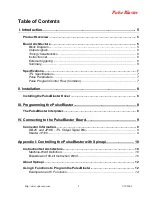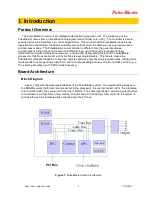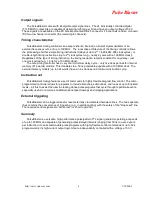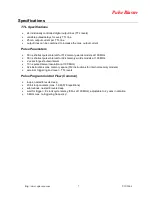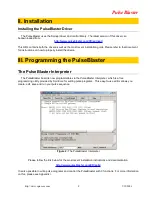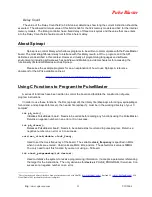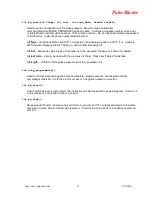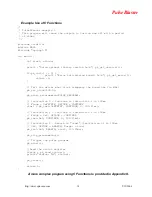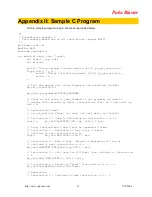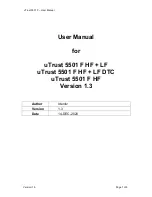
PulseBlaster
IV. Connecting to the PulseBlaster Board
Connector Information
DB-25 and JP300 - TTL Output Signal Bits
Outputs TTL signals generated by the user’s Program. Please consult the table below for bit
assignments.
DB-25 Pin Assignments
JP300 Pin Assignments
Pin#
Bit#
Pin#
Bit#
Pin#
Bit#
Pin#
Bit#
1
GND
14
GND
1
23
9
19
2
15
15
14
2
GND
10
GND
3
GND
16
13
3
22
11
18
4
12
17
GND
4
GND
12
GND
5
11
18
10
5
21
13
17
6
GND
19
9
6
GND
14
GND
7
8
20
GND
7
20
15
16
8
7
21
6
8
GND
16
GND
9
GND
22
5
10
4
23
GND
11
3
24
2
12
GND
25
1
13
0
Table 3:
Output bits and signals of the PulseBlaster
Header JP100
This is an input connector, for hardware triggering (HW_Trigger) and resetting (HW_Reset).
HW_Trigger
is pulled high by default, and pin 1 is active (pin 2 = GND). When a falling edge is
detected (e.g., when shorting pins 1-2), it initiates code execution. This trigger will also restart execution
of a program from the beginning of the code if it is detected after the design has reached an idle state.
The idle state could have been created either by reaching the STOP Op Code of a program, or by the
detection of the HW_Reset signal. When the WAIT Op Code is used in the pulse program, the
HW_Trigger will cause the program to continue to the next instruction.
HW_Reset
is pulled high by default, and pin 3 is active (pin 4 = GND). It can be used to halt the
execution of a program by pulling it low (e.g., by shorting pins 3-4). When the signal is pulled low during
the execution of a program, the controller resets itself back to the beginning of the program. Program
execution can be resumed by either a software start command or by a hardware trigger.
http://www.spincore.com
5/19/2006
9



